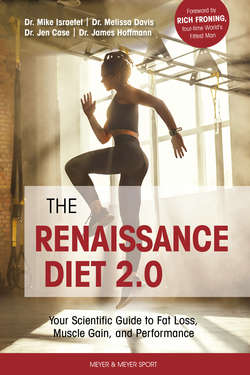Читать книгу The Renaissance Diet 2.0 - Mike Israetel, James Hoffmann - Страница 106
На сайте Литреса книга снята с продажи.
Minerals
ОглавлениеDietary minerals are naturally occurring chemical elements required by the body for basic function and health. Essential minerals include calcium, phosphorus, magnesium, and iron. Trace minerals–those needed in very small amounts, but potentially toxic in large amounts—include zinc, copper, manganese, iodine, selenium, molybdenum, and chromium.
Although all essential minerals are necessary for health purposes, for body composition and performance considerations, a subgroup of minerals called electrolytes are probably the most important. Electrolytes such as sodium, potassium, chloride, calcium, iron, and magnesium carry a positive or negative charge. This charge can impact cell function by altering cell membrane permeability. Such changes are responsible for neuronal firing in the central nervous system and muscle contractions in cardiac, smooth, and skeletal muscle tissue. Electrolyte balance also mediates hydration and blood pH–though only very severe imbalances can disturb blood pH as it is very tightly regulated.
It is important to replace electrolytes and fluids during activity, particularly if the activity is sweat-inducing: high intensity, prolonged duration, or occurring in a hot and humid environment. During and after such activity, electrolytes can help the body return to a homeostatic state. Consuming additional electrolyte beverages during such training is recommended.
Daily electrolyte needs for rest or light training are usually achieved with normal food consumption. Most people meet daily requirements of sodium and chloride easily as these two minerals are what make up table salt and are found in many foods and other seasonings.
Magnesium is also found in a variety of food products, such as spinach, beans, shellfish, and milk. The primary dietary source of calcium is usually dairy, but almond and soy milk as well as dark green leafy vegetables contain small amounts as well. Potassium can be found in most fruits and vegetables, with white potatoes and bananas having the highest amounts. Dietary sources of iron are divided into two categories, heme and non-heme iron. Non-heme iron is present in an oxidized form that must be reduced before it can be absorbed. Because it does not have this need for reduction, heme iron is absorbed at a much greater rate than non-heme iron. Heme iron comes mainly from meat, fish, and poultry. Non-heme iron can be found in plant sources, such as whole wheat and dark green vegetables.
Many people do not consume adequate amounts of iron; this is particularly true of vegans, vegetarians, and females of childbearing age, particularly if they experience heavy menstrual bleeding. For athletes this can be especially problematic. Chronically inadequate iron intake or absorption results in iron-deficiency anemia, which is a decrease in the number of healthy red blood cells able to carry oxygen. This means a decrease in the blood’s ability to deliver oxygen to working tissue where it is needed to produce energy for muscle contractions. Anemia can hinder high-volume weight training and cardio, as well as recovery from physical activity. A dietary supplement of iron may be needed for those limiting or avoiding the consumption of animal products, under-eating heme-iron for any reason, or those prone to iron deficiency.
